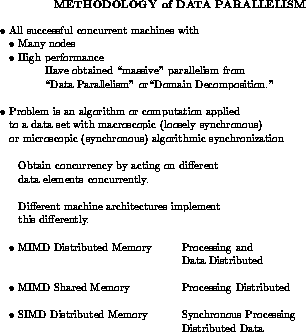




Next: Simulation of the
Up: Irregular Loosely Synchronous
Previous: Irregular Loosely Synchronous
This chapter contains some of the hardest applications we developed
within C P at Caltech. The problems are still ``just''
data-parallel with the natural ``massive'' (i.e., large scale as
directly proportional to the number of data elements or problem size)
loosely synchronous parallelism summarized in Figure 12.1.
However, the irregularity of the problem-both static and
dynamic-makes the implementation technically hard.
Interestingly, after this hard work, we do find very good speedups,
that is, this problem class has as much parallelism as the simpler
synchronous problems of Chapters 4 and 6. In
fact, one finds that it is in this class of problems that parallel
machines most clearly outperform traditional vector supercomputers
[Fox:89i;89n;90o].
The (dynamic) irregularity makes the parallelism harder to expose, but
it does not remove it; however, the irregularity of a problem can make
it impossible to get good performance on (SIMD) vector processors.
P at Caltech. The problems are still ``just''
data-parallel with the natural ``massive'' (i.e., large scale as
directly proportional to the number of data elements or problem size)
loosely synchronous parallelism summarized in Figure 12.1.
However, the irregularity of the problem-both static and
dynamic-makes the implementation technically hard.
Interestingly, after this hard work, we do find very good speedups,
that is, this problem class has as much parallelism as the simpler
synchronous problems of Chapters 4 and 6. In
fact, one finds that it is in this class of problems that parallel
machines most clearly outperform traditional vector supercomputers
[Fox:89i;89n;90o].
The (dynamic) irregularity makes the parallelism harder to expose, but
it does not remove it; however, the irregularity of a problem can make
it impossible to get good performance on (SIMD) vector processors.

Figure 12.1: Data Parallelism
The problems contained in this chapter are also typical of the hardest
challenges for parallelizing compilers. These
applications are not easy to write in a high-level language, such as
High Performance Fortran of Chapter 13, in a way that compilers
can efficiently extract the parallelism. This area is one of major
research activity with interesting contributions from the groups at
Yale [Bhatt:92a] and Stanford [Singh:92a] for the
N-body problem described in Section 12.4.
The applications in this chapter can be summarized as follows:
- Sections 12.2, 12.3: Adaptive unstructured
meshes-the data structure is an irregular graph-where we use the
DIME system of Chapter 10 to cope with the ``complication.'' A
domain-specific software tool, rather than a general compiler, has
been used.
- Section 12.6: Adaptive irregular clusters
superimposed on a regular grid. This application has essentially the
same parallelization issues as region finding in image
processing [Copty:92a].
- Section 12.7: Sorting features an adaptive treelike
(hierarchical) data structure.
- Sections 12.4, 12.5, 12.8: These combine a
hierarchical tree structure for fast calculation of forces with the
underlying geometric structure of the physical domain. The applications
are either ``pure'' particle simulations or a mix of particle and
continuum calculations. In the latter case, they generalize to
irregular dynamic problems the particle in the cell methods described in Section 9.3.
We suggest that Chapters 12, 14, and 18
contain some of those applications which should be studied by computer
scientists developing new software tools and parallel languages. This
is where the application programmer needs help! We have separated off
Chapter 14, as the violation of the loose
synchronization condition in this chapter
produces different complications from the dynamic irregularity that
characterizes the applications of Chapter 12.
Chapter 18 contains compound metaproblems combining all types of problem structure.





Next: Simulation of the
Up: Irregular Loosely Synchronous
Previous: Irregular Loosely Synchronous
Guy Robinson
Wed Mar 1 10:19:35 EST 1995
 P at Caltech. The problems are still ``just''
data-parallel with the natural ``massive'' (i.e., large scale as
directly proportional to the number of data elements or problem size)
loosely synchronous parallelism summarized in Figure 12.1.
However, the irregularity of the problem-both static and
dynamic-makes the implementation technically hard.
Interestingly, after this hard work, we do find very good speedups,
that is, this problem class has as much parallelism as the simpler
synchronous problems of Chapters 4 and 6. In
fact, one finds that it is in this class of problems that parallel
machines most clearly outperform traditional vector supercomputers
[Fox:89i;89n;90o].
The (dynamic) irregularity makes the parallelism harder to expose, but
it does not remove it; however, the irregularity of a problem can make
it impossible to get good performance on (SIMD) vector processors.
P at Caltech. The problems are still ``just''
data-parallel with the natural ``massive'' (i.e., large scale as
directly proportional to the number of data elements or problem size)
loosely synchronous parallelism summarized in Figure 12.1.
However, the irregularity of the problem-both static and
dynamic-makes the implementation technically hard.
Interestingly, after this hard work, we do find very good speedups,
that is, this problem class has as much parallelism as the simpler
synchronous problems of Chapters 4 and 6. In
fact, one finds that it is in this class of problems that parallel
machines most clearly outperform traditional vector supercomputers
[Fox:89i;89n;90o].
The (dynamic) irregularity makes the parallelism harder to expose, but
it does not remove it; however, the irregularity of a problem can make
it impossible to get good performance on (SIMD) vector processors.





